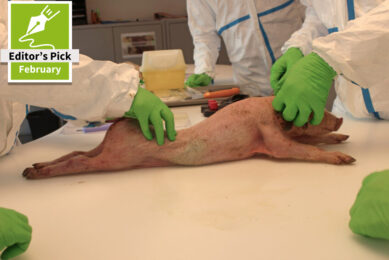Pig nutrition highlights discussed at Aussie conference
The Australian conference: Recent Advances in Animal Nutrition (held 12-15 July in Armidale) brought together animal nutrition experts to discuss issues that are of importance to the livestock industry. Tony Edwards from ACE Livestock Consulting spoke about significant breakthroughs in pig nutrition during the past 30 years and touched some future challenges for the industry.
Pig production worldwide has advanced remarkably during the past three decades. In the 1970s in Australia, pigs grew with 450 g/d; sows produced 16 piglets per year and a normal FCR was about 5.5. Currently, pigs grow at 680 g/d; reach 24 piglets per sow per year and need 3.6 kg to grown one kg of pork. Although much of this progress has been mediated by small but incremental improvements in production, sporadic but significant breakthroughs have accelerated this progress. “Those who have not witnessed this progression may consider these advances common knowledge and may be unaware of the profound shift in thinking that they induced at the time” according to Edwards, being in the business for more than 30 years himself.
Breakthroughs
Edwards explained in his presentation the most significant breakthrough in pig nutrition. These are:
The development of the ideal protein concept: This approach replaced previous methods of protein quality assessment such as the protein efficiency ratio, net protein utilization, nitrogen retention and biological value.
The relationship between protein, energy and growth: Quantification of the relationship between protein and energy in pig metabolism and growth by the Werribee Group (e.g., Campbell, 1987) and others resulted in a significant change in diet formulation procedures because of the development of protein to energy ratios for various stages of development, sexes and genotypes.
Application of supplementary enzymes: Enzyme additives have improved the digestion of nutrients by abrogating the inhibitory effects of compounds such as arabinoxylans, ß-glucans, pectins, oligosaccharides, phytate, cellulose and protein-encapsulated starch and by supporting limited endogenous secretion of enzymes such as such as amylase, sucrase and proteases.
Development of mycotoxin binders: Breakthroughs have been achieved using various technologies that have resulted in effective, if not complete, detoxification. These include yeast-derived glucomannans, enhanced alumina silicates and bacterial/enzymic hydrolysis of active toxic components.
The use of metabolic modifiers: Exogenous porcine somatotrophin (pST) is possibly the most performance-enhancing technology that has emerged during the past 30 years (not allowed in EU). Other metabolic modifiers include the oral product Paylean®, a ß-agonist repartitions nutrients away from fat deposition to muscle deposition, and thus increasing feed efficiency.
The measurement of feedstuff quality using near infra-red reflectance technology: The application of NIR technology to stockfeed analysis evolved over many years and is now used in most quality assurance protocols to monitor a wide range of nutrients within feed ingredients and feeds.
Use the potential
Despite this progress, current production levels are still less than the biological potential of pigs, Edwards explained. Although there will no doubt be further nutritional breakthroughs in the future, concurrent progress in other disciplines such as health and management is required to realise this potential. Topics worthy of further investigation include management of the differential digestion rates of nutrients from various sources, immunity × nutrition interactions, roles of specific amino acids in processes other than tissue accretion and alternative ways of exploiting liquid feeding regimens. Considering the sustained pressure on livestock producers to reduce environmental impacts and optimise animal welfare, the on-going pursuit of advances in nutrition will be fundamental to the sustainability of pig production, Edwards concluded.
Related link:











